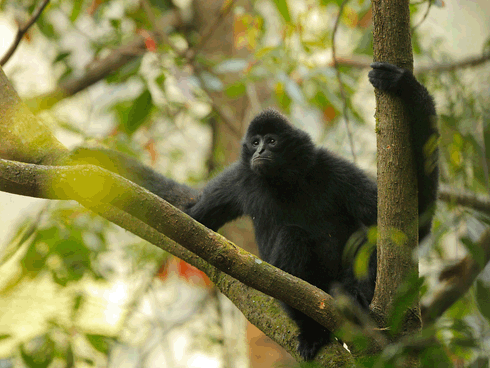
|
Published: 28 May 2012
Survival of Vietnam’s unique gibbons at risk
A comprehensive study of gibbons in Vietnam has found that three of its six species – the eastern and western black gibbons and the northern white-cheeked gibbon – are close to extinction, and the remaining three have suffered massive population reductions.
The publication, The Conservation Status of Gibbons in Vietnam, co-authored by Fauna & Flora International (FFI) and Conservation International (CI), reports that over the last 10 years, gibbons have disappeared from much of their historical range in Vietnam.
The few remaining viable populations are restricted to protected areas which, in almost all cases, lack the level of protection needed to ensure their survival.
‘Vietnam is an incredibly important location for gibbons globally, with six different species, all of which are threatened by extinction’, said Ben Rawson, CI’s regional primatologist.
‘Awareness of the plight of the gibbons nationally is very low, which is a major contributing factor to their ongoing decline.
‘While gibbons are afforded the highest level of legal protection in Vietnam, this is not widely appreciated by either law enforcement officials or local communities...populations are being whittled away, individual by individual, to the point where many areas no longer contain viable populations.’
Rawson says hunting and habitat loss through land conversion have driven the dramatic recent declines in gibbon populations. Habitat loss continues inside protected areas through illegal logging, agricultural encroachment and infrastructure developments, such as hydropower dams and roads.
This brings improved access to the forest for those hunting gibbons for food or the wildlife trade, fuelled by the demand for exotic pets and unfounded beliefs in some cultures in the medicinal properties of gibbon body parts.
Habitat loss also causes population fragmentation, leading to ever smaller and more vulnerable subpopulations.
‘To thrive, gibbon populations need relatively large tracks of reasonably intact forest and this is increasingly rare in Vietnam,’ said Dr Ulrike Streicher, a veterinarian working for FFI in Vietnam. ‘The small local successes we have thus far achieved in gibbon conservation, for example in the Cao Vit Gibbon Conservation Area in Cao Bang Province, give reason for hope, but a lot more needs to be done.’
‘Gibbons are wonderfully charismatic and gentle creatures, which do not harm anyone’s livelihoods, but charm us with their beauty, acrobatics, song, and they are our closest relatives in Vietnam,’ said researcher Nguyen Manh Ha from the Vietnam National University.
‘If nothing can be done to secure the long-term future of gibbons in Vietnam, what hope is there for the rest of Vietnam’s biodiversity and the fragile environment its human population depends upon?’
Last year, the death of the last rhinoceros in Vietnam was announced, sending a sub-species to extinction and eradicating rhino from mainland SE Asia.
The FFI/CI report says that saving Vietnam’s gibbons will require increased funding, major improvements in protected area management and biodiversity conservation, and a radical shift in government and public attitudes towards Vietnam’s environment and wildlife.
Source: Conservation International




